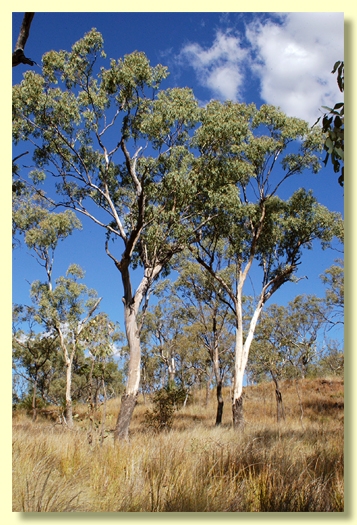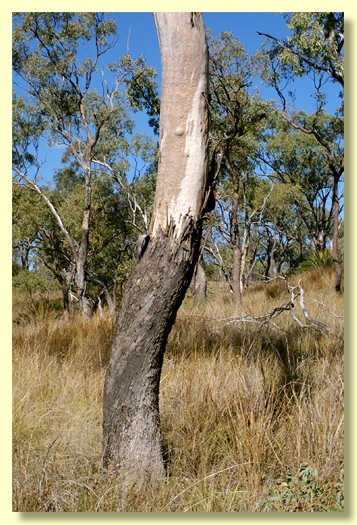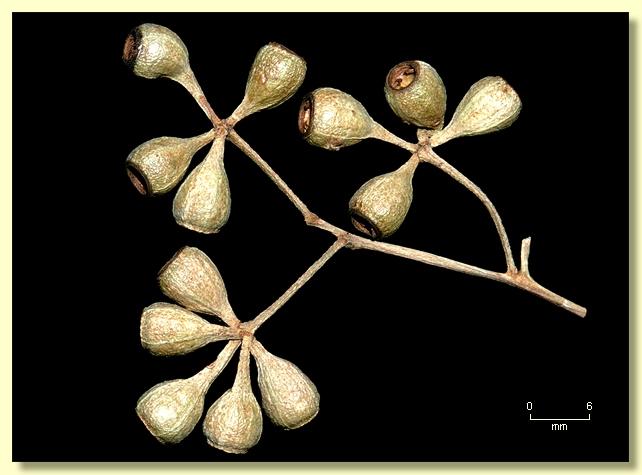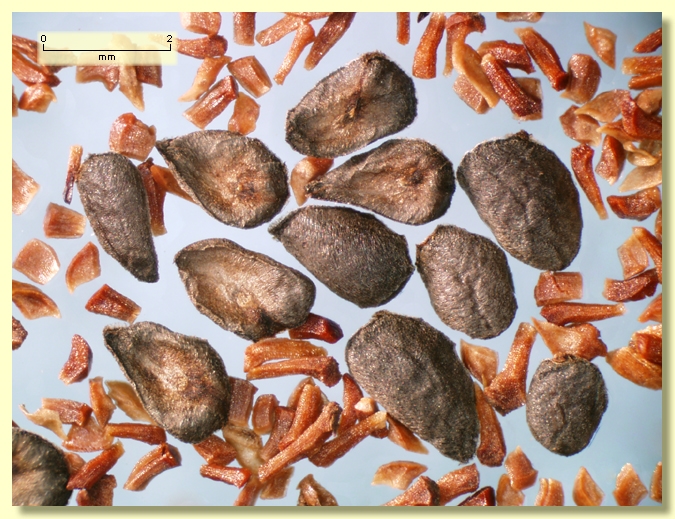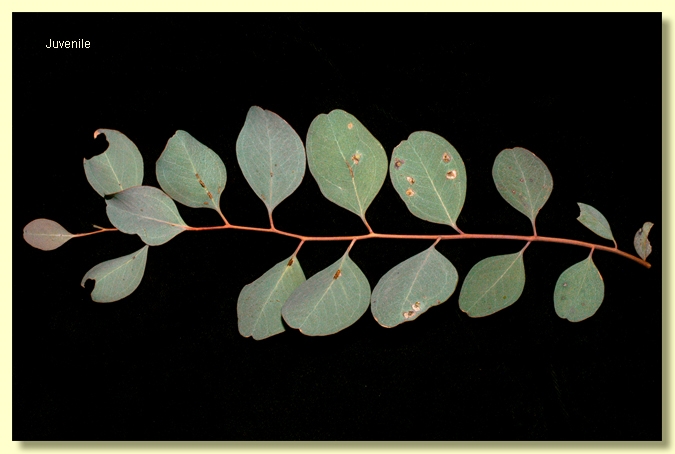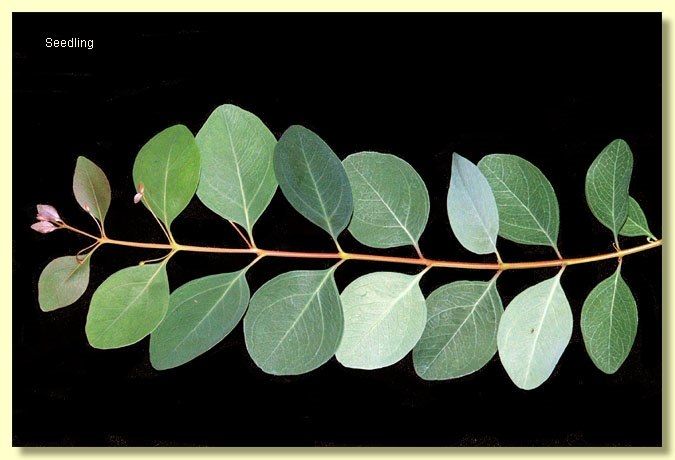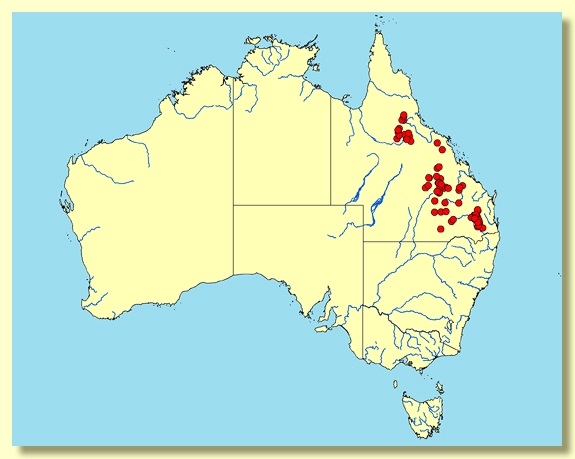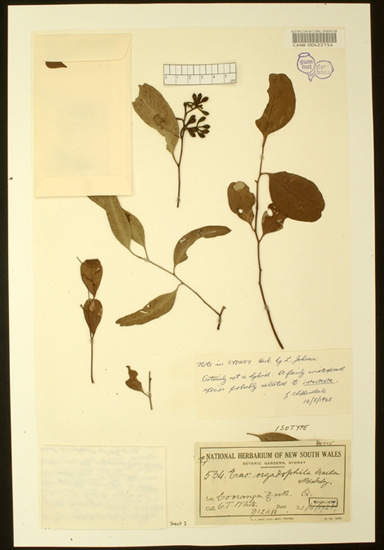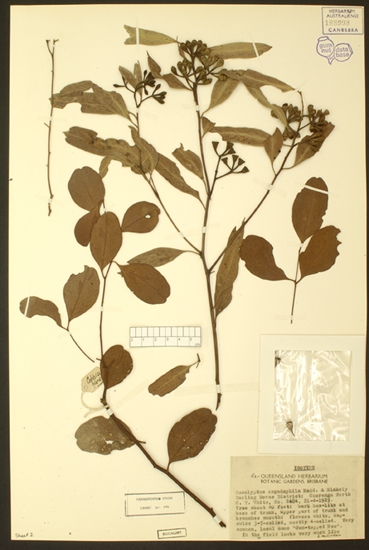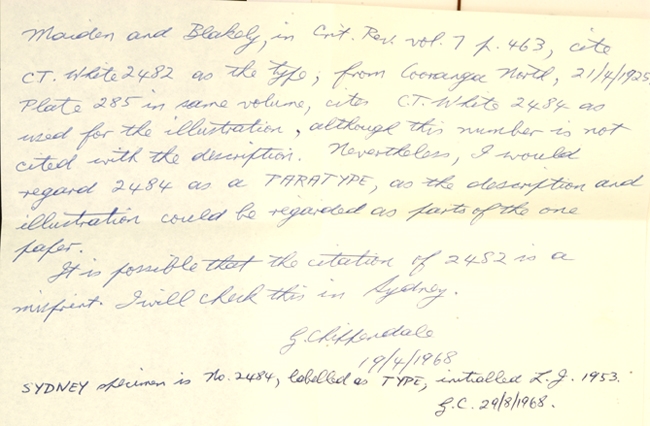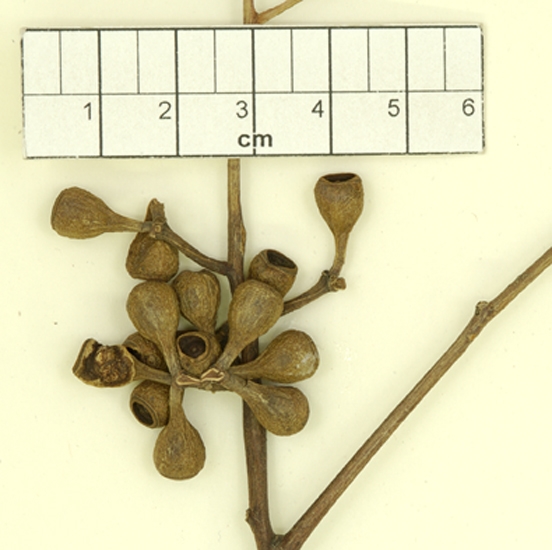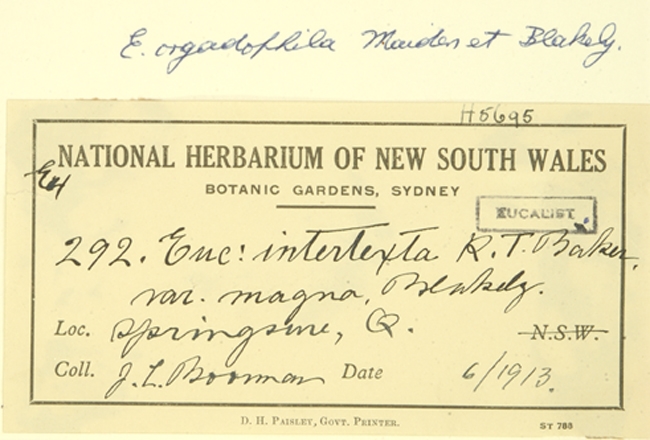Euclid - Online edition
Eucalyptus orgadophila
Eucalyptus | Symphyomyrtus | Adnataria | Apicales | Buxeales | Amissae
Tree to 20 m tall. Forming a lignotuber.
Bark rough on the lower trunk, box-type, grey with abrupt change to smooth bark, which is normally white to grey, rarely creamy brown, sometimes shiny.
Juvenile growth (coppice or field seedlings to 50 cm): stems square in cross-section; juvenile leaves petiolate, alternate, orbicular to ovate to elliptical, 3–6 cm long, 1.8–4 cm wide, base round to tapering to petiole, dull, blue-grey to green to rarely glaucous.
Adult leaves alternate, petiole 1–2.2 cm long; blade lanceolate, 6.5–18 cm long, 1–2.5(3.5) cm wide, base tapering to petiole, concolorous, dull, green to grey-green to blue-grey to rarely glaucous, side-veins acute, reticulation dense to very dense, intramarginal vein parallel to and close to the margin, oil glands absent or obscure.
Inflorescence terminal compound or axillary single umbels, peduncles 0.8–1.6 cm long, buds 7 per umbel, pedicels 0.5–0.9 cm long. Mature buds obovoid to pyriform, sometimes the angled petiole extending onto the hypanthium to produce two longitudinal ridges, 0.7–0.9 cm long, 0.4–0.6 cm wide, usually not glaucous, rarely glaucous, scar present, operculum rounded to beaked, stamens irregularly flexed, staminodes absent, anthers adnate, basifixed, cuboid or globoid, style long, stigma blunt, locules 4, the placentae each with 4 vertical ovule rows. Flowers white.
Fruit on pedicels 0.2–1 cm long, cup-shaped to barrel-shaped, sometimes the angled pedicel extending onto the hypanthium to produce two longitudinal ridges, (0.5)0.7–1.1 cm long, 0.6–1 cm wide, disc descending, valves normally 4, enclosed.
Seeds dark brown to grey, 1.8–3.5 mm long, flattened-ovoid, sometimes pointed at one end, dorsal surface shallowly reticulate, hilum ventral.
Cultivated seedling: cotyledons small, reniform; stems square in cross-section; leaves always petiolate, opposite for 7 to 11 nodes then becoming alternate, broadly elliptic to ovate or ± orbicular, rarely broadly lanceolate, 3–9.5 cm long, 2–6 cm wide, green to grey-green to rarely glaucous, discolorous, dull.
Flowering has been recorded in February, April, May, July, August and September.
A medium-sized tree known from four, more or less, disjunct populations in eastern Queensland, the first from just north of Warwick in the Upper Pilton area north through the Dalby area to just west of Kingaroy; the second from the Surat – St George – Mitchell area north to just south-east of Taroom and just west of Roma and then further north through the Rolleston area to just south-east of Clermont; the third from just west of Eungella to just south of Collinsville; and the fourth from west of Charters Towers to north of Hughenden and then north to the Conjuyboy area south-east of Mt Surprise. Eucalyptus orgadophila is characterised by its rough basal box bark on the trunk and its conspicuously smooth-barked upper trunk and branches, its relatively broad juvenile leaves, its dull green to grey-green to blue-grey to rarely glaucous adult leaves, terminal inflorescences, buds with an operculum scar and no staminodes, and cup-shaped to barrel-shaped fruit to 1 cm wide.
Very closely related to E. intertexta and differs only marginally by having larger fruit (0.6–1 cm wide for E. orgadophila and 0.4–0.7 cm wide in E. intertexta) and orbicular to ovate to elliptical juveniles to 6 cm long (normally lanceolate and to 12 cm long in E. intertexta). Also closely related to E. cambageana, which differs by having glossy green adult leaves and smaller fruit 0.5–0.6 cm wide.
Within the box group, it could be confused with other species that have basal rough bark and conspicuously smooth-barked upper trunks and branches, i.e. E. ochrophloia, E. thozetiana, E. acroleuca and E. coolabah. E. ochrophloia and E. thozetiana differ from E. orgadophila by having buds lacking an operculum scar (both inner and outer operculum shed at flowering time) and having sterile outer stamens (staminodes).E. acroleuca and E. coolabah have much smaller thin-walled fruit than E. orgadophila (fruit 0.2–0.3 cm diameter in E. acroleuca and 0.3–0.5 cm diameter in E. coolabah).
Eucalyptus orgadophila belongs in Eucalyptus subgenus Symphyomyrtus section Adnataria (the boxes) because the buds have two opercula, ovules are in four rows, seeds are flattened-ovoid, cotyledons are reniform, and anthers are rigid on the staminal filaments. Within section Adnataria, E. orgadophila is in a subgroup, series Buxeales, further distinguished by terminal inflorescences, buds with an operculum scar (outer operculum shed early), all stamens being fertile, and by dull, not glossy adult leaves. The species most closely related to E. orgadophila are the arid zone species E. intertexta and E. largiflorens from the Murray-Darling River system floodplains. E. intertexta differs as outlined above whilst E. largiflorens is fully rough-barked and has linear juvenile leaves.
Eucalyptus orgadophila: Greek orgados, a meadow or well-watered fertile spot and philos, loving, referring to the preferred habitat for this species.

